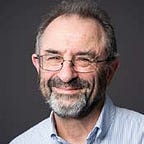Create Your Own ‘Back to the Future’
The Tokyo Olympics finished yesterday.
After 17 days of intense competition with many individual highs and plenty of individual stories of years of hard training, of support of family and teams, of overcoming setbacks.
Many a competitor was asked how they prepared for their event in the days preceding. Their answers often included reference to visualisation. They visualised themselves in action — whether clearing the bar, powering through the water, landing a punch or racing to the finishing line.
Visualisation has been part of sports preparation for many years now. It involves seeing yourself in the future performing in a certain way.
A form of visualisation can also be used more generally as a creative thinking tool. I call it ‘Backcasting’ and use it with Mind Mapping. It is like a reversed ‘Back to the Future’. In the classic 1985 movie, Marty McFly finds himself accidentally in 1955 and has to figure out how to return to his present day.
With Backcasting, you start with a visualised future and then work out how you got there.
Here’s the process:
- Identify the desired future for your situation
- From the perspective of the desired future, imagine what must have happened for it to have occurred
- Brainstorm how you made these things happen
Let’s look at a situation using Backcasting.
A few years ago I was with a group in a meeting room in Torbay, UK on a weekday evening. The group (Creative Thinking Torbay) met regularly to do creative thinking on behalf of local charitable and non-profit organisations. Two representatives of the charity were present. They told us about their work and where they could use some new ideas. In this case, their organisation needed to increase its number of volunteers.
We decided to use the Backcasting tool to help generate some ideas for them.
Step 1 — Identify the desired Future. we asked them to tell us what success would look like for their issue. They said “success would be having plenty of volunteers who make an important contribution to our work and get their own fulfilment from doing it”
Instead of asking what would success look like, we could have asked questions like:
· What would be some great outcomes for….?
· What are your best hopes for…?
Step 2 — We imagined what must have happened for the desired future to have occurred
Working in small groups, we concluded that they must have
· found a new source of volunteers
· found a way to attract them to the organisation
· developed a way of retaining the volunteers, maintaining their interest
Step 3 — for each approach, we asked how did they do this?
a) ‘Found a new source’ — who might it have been? Students interested in pursuing careers in social work, psychology, social care? Or perhaps, retired people recently moved to the area (a coastal resort)?
b) Found a way to attract them to our organisation — how did they do this?
- Advertised in new places — students: in the college media? retirees: find out what media they might look for?
- Had a stand at the college’s employment open day?
- Held social mornings/events with tea and cake?
c) Developed a way of retaining them, maintaining their interest
- New form of volunteer organisation? Find a student to be a volunteer organiser — higher level work experience?
- Volunteer meet ups? Social events?
- Interesting training days?
Here’s a mind map of the thinking with further questions which the ideas provoked.
The next time you need to generate some new ideas, try using the Backcasting tool:
- Identify the desired future
- Imagine what must have happened for you to have achieved it
- Brainstorm how you made these happen
Peter Redstone and his artist wife live in South Devon, UK in a converted cowshed. Their 4 children all grew up on the farm before spreading their wings. Peter was a management consultant in the 1970’s, an organic dairy farmer and ice cream maker in the 1980’s and 90’s and now delivers science leadership training. He teaches creative thinking and admits to being a mind mapping missionary.
